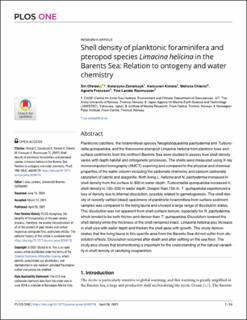| dc.description.abstract | Planktonic calcifiers, the foraminiferal species Neogloboquadrina pachyderma and Turborotalita quinqueloba, and the thecosome pteropod Limacina helicina from plankton tows and surface sediments from the northern Barents Sea were studied to assess how shell density varies with depth habitat and ontogenetic processes. The shells were measured using X-ray microcomputed tomography (XMCT) scanning and compared to the physical and chemical properties of the water column including the carbonate chemistry and calcium carbonate saturation of calcite and aragonite. Both living L. helicina and N. pachyderma increased in shell density from the surface to 300 m water depth. Turborotalita quinqueloba increased in shell density to 150–200 m water depth. Deeper than 150 m, T. quinqueloba experienced a loss of density due to internal dissolution, possibly related to gametogenesis. The shell density of recently settled (dead) specimens of planktonic foraminifera from surface sediment samples was compared to the living fauna and showed a large range of dissolution states. This dissolution was not apparent from shell-surface texture, especially for N. pachyderma, which tended to be both thicker and denser than T. quinqueloba. Dissolution lowered the shell density while the thickness of the shell remained intact. Limacina helicina also increase in shell size with water depth and thicken the shell apex with growth. This study demonstrates that the living fauna in this specific area from the Barents Sea did not suffer from dissolution effects. Dissolution occurred after death and after settling on the sea floor. The study also shows that biomonitoring is important for the understanding of the natural variability in shell density of calcifying zooplankton. | |
